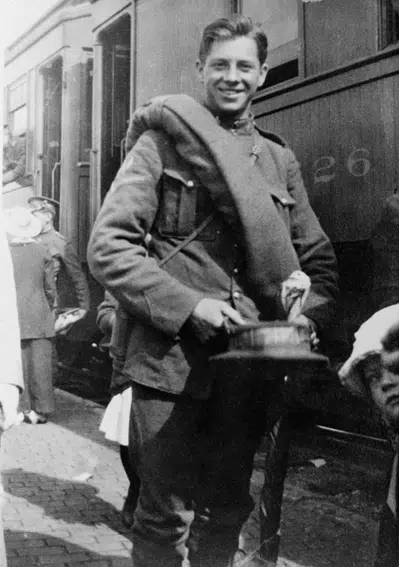
Source: release
A Canadian soldier who served in the First World War has been identified. Through extensive historical and archival research, a previously unknown grave has been identified as Corporal Frederick Percival Bousfield. The grave was in Bedford House Cemetary in Ypres, Belgium.
“Percy” Bousfield was born in England in 1896 in Cotehill, Cumberland. He was one of nine children to Frederick Ladlay Bousfield and Hannah Bousfield (née Lloyd). At the age of 14, he travelled around the world working on sailing vessels as part of the mercantile service, out of Glasgow. His family immigrated to Canada in 1912, moving to Quebec, but settling in Winnipeg. He joined them there and enlisted with The 79th Cameron Highlanders of Canada, a militia unit. He worked in Quebec City and Halifax, inspecting vessels, and as a carpenter in Winnipeg. On January 29, 1915, he attested for overseas service and was assigned to the Signals Section of the 43rd Canadian Infantry Battalion, Canadian Expeditionary Force (CEF). After training in England, he was promoted to the rank of corporal and was sent to France in February 1916.
The 43rd Battalion participated in the Battle of Mount Sorrel outside Ypres, Belgium June 2-13, 1916. There, Canadians defended their position on a piece of high ground. According to letters that his family has received from members of the Battalion, he was struck by an enemy shell that killed him. He had been carrying wounded men to safety and was going back for another stretcher. Many men said he showed great courage in the moments before his death. He was 20-years old.
The Canadian Armed Forces has notified the family of Corporal Bousfield’s identification and is providing them with ongoing support. A headstone rededication ceremony will take place at the earliest opportunity at the Commonwealth War Graves Commission’s Bedford House Cemetery in Ypres, Belgium.
“Corporal Bousfield made the ultimate sacrifice while helping wounded comrades to safety, saving lives and laying down his own in the process. The story of his selfless commitment brings us grief and inspiration over a century later. We must never forget this young man and the others like him who served their country with such courage. To his family, I extend my sympathy and gratitude.”
-The Honourable Anita Anand, Minister of National Defence
“Corporal Bousfield’s name was engraved on the Menin Gate Memorial, along with the other soldiers killed in the Ypres Salient in Belgium during the First World War who have no known grave. Now, his final resting place is known. His courage and commitment to service before self must never be forgotten. That is the debt we owe him, and all fallen Canadian soldiers and their families.”
-The Honourable Lawrence MacAulay, Minister of Veterans Affairs and Associate Minister of National Defence
Quick Facts
- Frederick Percival Bousfield was born on March 8, 1896 in Cotehill, Cumberland, England, the son of Frederick Ladlay Bousfield and Hannah Bousfield (née Lloyd).
- After the war, Corporal Bousfield’s name was engraved on panel 24 of the Ypres (Menin Gate) Memorial. The Memorial was erected to honour the soldiers killed in the Ypres Salient in Belgium during the First World War who have no known grave.
- In October 2019, the Directorate of History and Heritage (DHH) received a report from the Commonwealth War Graves Commission (CWGC) detailing the potential identification of Grave 68, Row C, Plot 11 in Enclosure No. 4 of the Bedford House Cemetery in Ypres, Belgium. Three separate independent researchers had raised the possibility that this grave was that of Corporal Bousfield. Extensive research was undertaken by both CWGC and DHH to corroborate the possible identification, and in October 2021, the Casualty Identification Review Board confirmed the identification. The Board is made up of members and observers from DHH, CWGC, the Canadian Forces Forensic Odontology Response Team, and the Canadian Museum of History.
- The Canadian Armed Forces Casualty Identification Program, within DHH, identifies unknown Canadian service members when their remains are recovered. The program also identifies service members previously buried as unknown soldiers when there is sufficient evidence to confirm the identification.
- The Commonwealth War Graves Commission commemorates the 1.7 million Commonwealth servicemen and women who died during the two world wars. Using an extensive archive, the Commission works with their partners to recover, investigate, and identify those with no known grave in order to give them the dignity of burial and the commemoration they deserve.





